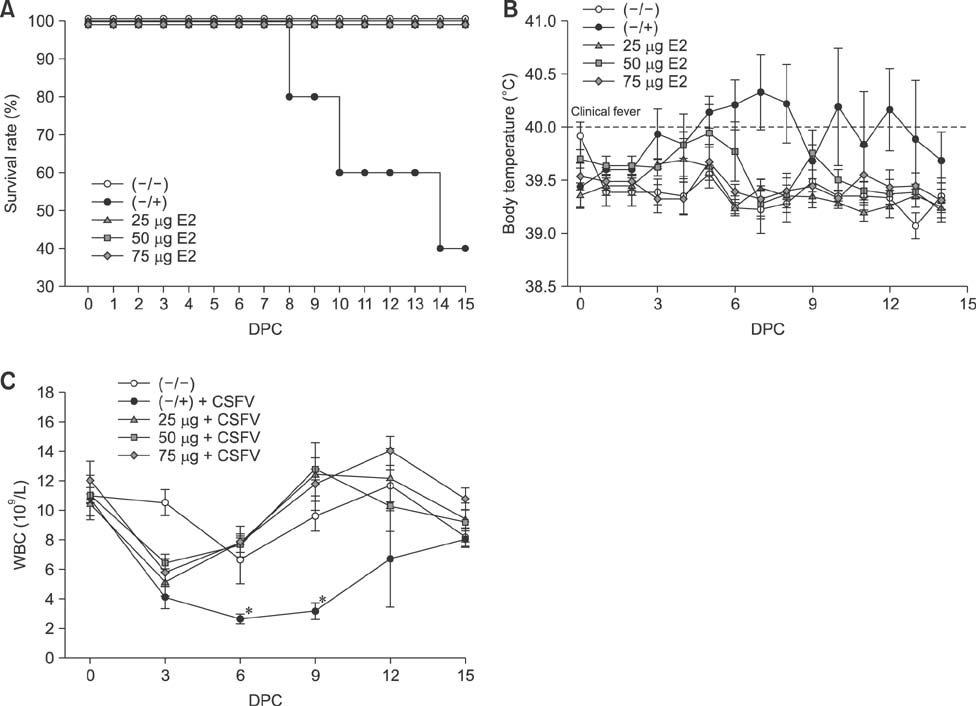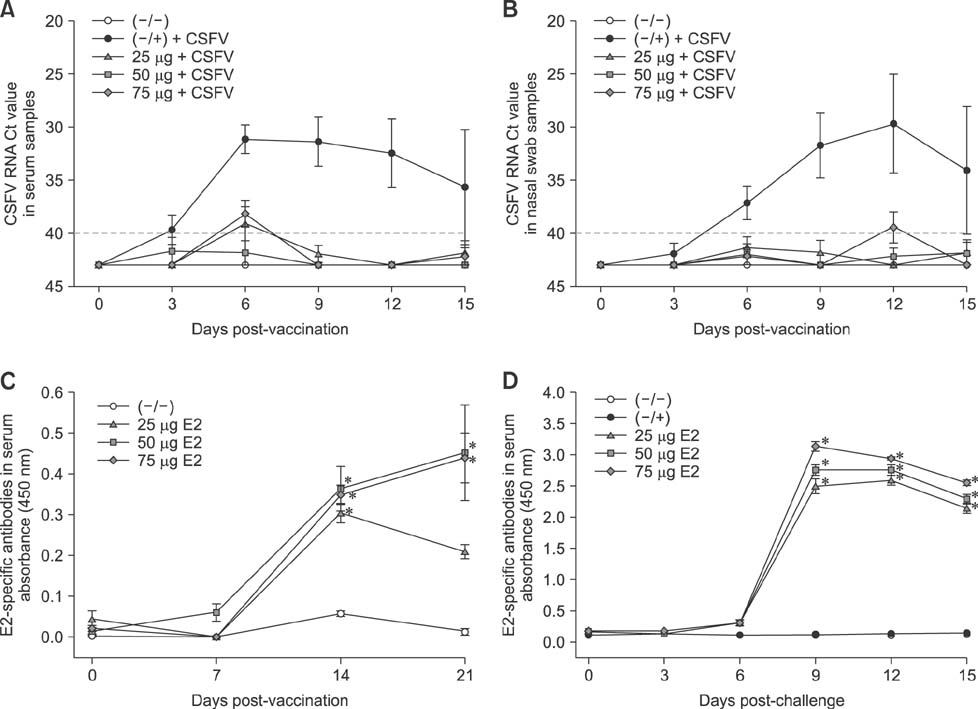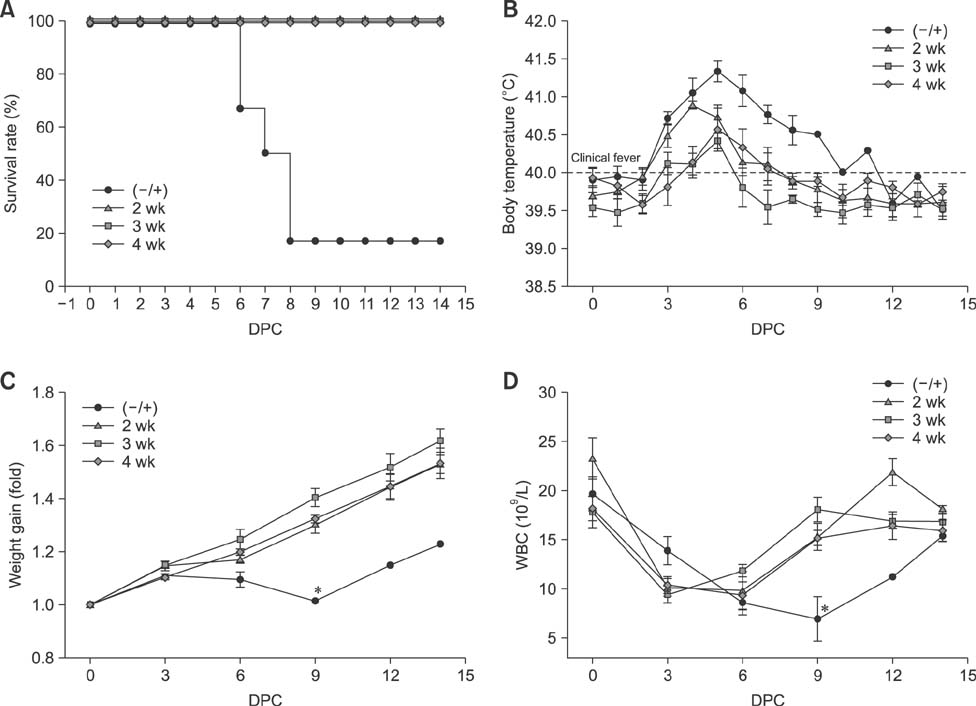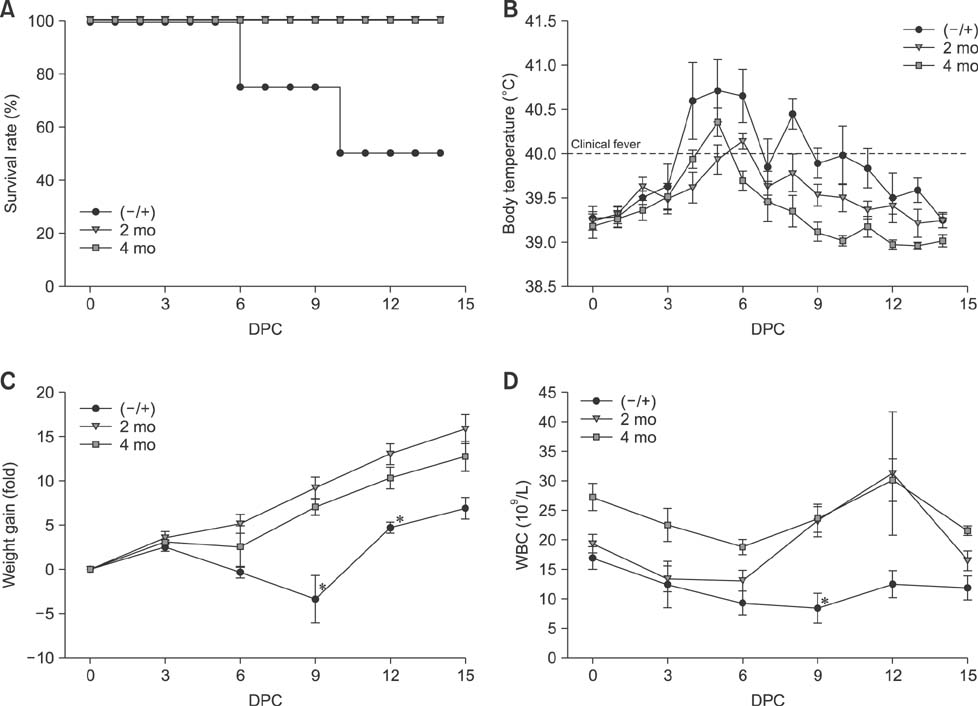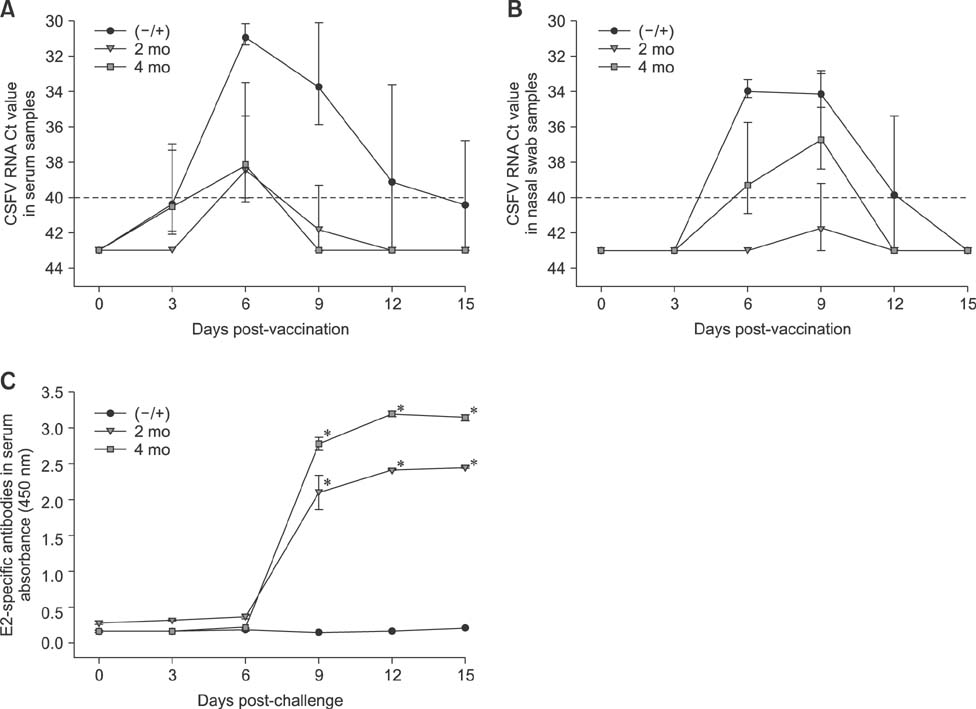J Vet Sci.
2018 May;19(3):393-405. 10.4142/jvs.2018.19.3.393.
Toward the development of a one-dose classical swine fever subunit vaccine: antigen titration, immunity onset, and duration of immunity
- Affiliations
-
- 1Department of Anatomy and Physiology, College of Veterinary Medicine, Kansas State University, Manhattan, KS 66506, USA. jshi@ksu.edu
- 2Institute of Military Veterinary Medicine, Academy of Military Medical Sciences, Changchun 130062, China.
- 3Department of Diagnostic Medicine and Pathobiology, College of Veterinary Medicine, Kansas State University, Manhattan, KS 66506, USA.
- KMID: 2412130
- DOI: http://doi.org/10.4142/jvs.2018.19.3.393
Abstract
- Highly contagious classical swine fever (CSF) remains a major trade and health problem in the pig industry, resulting in large economic losses worldwide. In CSF-endemic countries, attenuated CSF virus (CSFV) vaccines have been routinely used to control the disease. However, eradication of CSFV in a geographical area would require permanent reduction to zero presence of the virus. It is therefore of paramount importance to develop a safe, potent, and non-infectious CSF vaccine. We have previously reported on a cost-effective CSF E2 subunit vaccine, KNB-E2, which can protect against CSF symptoms in a single dose containing 75 µg of recombinant CSFV glycoprotein E2. In this study, we report on a series of animal studies undertaken to elucidate further the efficacy of KNB-E2. We found that pigs vaccinated with a single KNB-E2 dose containing 25 µg of recombinant CSFV glycoprotein E2 were protected from clinical symptoms of CSF. In addition, KNB-E2-mediated reduction of CSF symptoms was observed at two weeks post-vaccination and the vaccinated pigs continued to exhibit reduced CSF clinical signs when virus challenged at two months and four months post-vaccination. These results suggest that KNB-E2 effectively reduces CSF clinical signs, indicating the potential of this vaccine for safely minimizing CSF-related losses.
Keyword
Figure
Reference
-
1. Ahrens U, Kaden V, Drexler C, Visser N. Efficacy of the classical swine fever (CSF) marker vaccine Porcilis® Pesti in pregnant sows. Vet Microbiol. 2000; 77:83–97.
Article2. Aucouturier J, Dupuis L, Ganne V. Adjuvants designed for veterinary and human vaccines. Vaccine. 2001; 19:2666–2672.
Article3. Beer M, Reimann I, Hoffmann B, Depner K. Novel marker vaccines against classical swine fever. Vaccine. 2007; 25:5665–5670.
Article4. Blome S, Meindl-Böhmer A, Loeffen W, Thuer B, Moennig V. Assessment of classical swine fever diagnostics and vaccine performance. Rev Sci Tech. 2006; 25:1025–1038.5. Blome S, Moß C, Reimann I, König P, Beer M. Classical swine fever vaccines: state-of-the-art. Vet Microbiol. 2017; 206:10–20.6. Bouma A, De Smit AJ, De Jong MC, De Kluijver EP, Moormann RJ. Determination of the onset of the herd-immunity induced by the E2 sub-unit vaccine against classical swine fever virus. Vaccine. 2000; 18:1374–1381.
Article7. Bouma A, de Smit AJ, de Kluijver EP, Terpstra C, Moormann RJ. Efficacy and stability of a subunit vaccine based on glycoprotein E2 of classical swine fever virus. Vet Microbiol. 1999; 66:101–114.
Article8. de Smit AJ, Bouma A, de Kluijver EP, Terpstra C, Moormann RJ. Duration of the protection of an E2 subunit marker vaccine against classical swine fever after a single vaccination. Vet Microbiol. 2001; 78:307–317.
Article9. Dewulf J, Laevens H, Koenen F, Mintiens K, de Kruif A. An E2 sub-unit marker vaccine does not prevent horizontal or vertical transmission of classical swine fever virus. Vaccine. 2001; 20:86–91.
Article10. Di Pasquale A, Preiss S, Tavares Da Silva F, Garçon N. Vaccine adjuvants: from 1920 to 2015 and beyond. Vaccines (Basel). 2015; 3:320–343.
Article11. Dong XN, Chen YH. Marker vaccine strategies and candidate CSFV marker vaccines. Vaccine. 2007; 25:205–230.
Article12. Dowling JK, Mansell A. Toll-like receptors: the Swiss Army knife of immunity and vaccine development. Clin Transl Immunology. 2016; 5:e85.
Article13. Flori L, Gao Y, Laloë D, Lemonnier G, Leplat JJ, Teillaud A, Cossalter AM, Laffitte J, Pinton P, de Vaureix C, Bouffaud M, Mercat MJ, Lefèvre F, Oswald IP, Bidanel JP, Rogel-Gaillard C. Immunity traits in pigs: substantial genetic variation and limited covariation. PLoS One. 2011; 6:e22717.
Article14. Fox CB, Kramer RM, Barnes VL, Dowling QM, Vedvick TS. Working together: interactions between vaccine antigens and adjuvants. Ther Adv Vaccines. 2013; 1:7–20.
Article15. Galliher-Beckley A, Pappan LK, Madera R, Burakova Y, Waters A, Nickles M, Li X, Nietfeld J, Schlup JR, Zhong Q, McVey S, Dritz SS, Shi J. Characterization of a novel oil-in-water emulsion adjuvant for swine influenza virus and Mycoplasma hyopneumoniae vaccines. Vaccine. 2015; 33:2903–2908.
Article16. Gomez-Villamandos JC, Salguero FJ, Ruiz-Villamor E, Sánchez-Cordón PJ, Bautista MJ, Sierra MA. Classical swine fever: pathology of bone marrow. Vet Pathol. 2003; 40:157–163.
Article17. Graham SP, Everett HE, Haines FJ, Johns HL, Sosan OA, Salguero FJ, Clifford DJ, Steinbach F, Drew TW, Crooke HR. Challenge of pigs with classical swine fever viruses after C-strain vaccination reveals remarkably rapid protection and insights into early immunity. PLoS One. 2012; 7:e29310.
Article18. Guy B. The perfect mix: recent progress in adjuvant research. Nat Rev Microbiol. 2007; 5:505–517.
Article19. Hoffmann B, Beer M, Schelp C, Schirrmeier H, Depner K. Validation of a real-time RT-PCR assay for sensitive and specific detection of classical swine fever. J Virol Methods. 2005; 130:36–44.
Article20. Hua RH, Huo H, Li YN, Xue Y, Wang XL, Guo LP, Zhou B, Song Y, Bu ZG. Generation and efficacy evaluation of recombinant classical swine fever virus E2 glycoprotein expressed in stable transgenic mammalian cell line. PLoS One. 2014; 9:e106891.
Article21. Huang YL, Deng MC, Wang FI, Huang CC, Chang CY. The challenges of classical swine fever control: modified live and E2 subunit vaccines. Virus Res. 2014; 179:1–11.
Article22. Hulst MM, Moormann RJ. Inhibition of pestivirus infection in cell culture by envelope proteins E(rns) and E2 of classical swine fever virus: E(rns) and E2 interact with different receptors. J Gen Virol. 1997; 78:2779–2787.
Article23. Kahn CM. The Merck Veterinary Manual. 9th ed. Whitehouse Station and Great Britain: Merck & Co.;2005.24. Klinge KL, Vaughn EM, Roof MB, Bautista EM, Murtaugh MP. Age-dependent resistance to Porcine reproductive and respiratory syndrome virus replication in swine. Virol J. 2009; 6:177.
Article25. König M, Lengsfeld T, Pauly T, Stark R, Thiel HJ. Classical swine fever virus: independent induction of protective immunity by two structural glycoproteins. J Virol. 1995; 69:6479–6486.
Article26. Lin GJ, Deng MC, Chen ZW, Liu TY, Wu CW, Cheng CY, Chien MS, Huang C. Yeast expressed classical swine fever E2 subunit vaccine candidate provides complete protection against lethal challenge infection and prevents horizontal virus transmission. Vaccine. 2012; 30:2336–2341.
Article27. Lindenbach BD, Murray CL, Thiel HJ, Rice CM. Flaviviridae. In : Knipe DM, Howley PM, editors. Fields Virology. Philadelphia: Lippincott Williams and Wilkins;2013. p. 712–747.28. Luo Y, Li S, Sun Y, Qiu HJ. Classical swine fever in China: a minireview. Vet Microbiol. 2014; 172:1–6.
Article29. Madera R, Gong W, Wang L, Burakova Y, Lleellish K, Galliher-Beckley A, Nietfeld J, Henningson J, Jia K, Li P, Bai J, Schlup J, McVey S, Tu C, Shi J. Pigs immunized with a novel E2 subunit vaccine are protected from subgenotype heterologous classical swine fever virus challenge. BMC Vet Res. 2016; 12:197.
Article30. Mallard BA, Wilkie BN. Phenotypic, genetic and epigenetic variation of immune response and disease resistance traits of pigs. Adv Pork Prod. 2007; 18:139–146.31. Moormann RJ, Bouma A, Kramps JA, Terpstra C, De Smit HJ. Development of a classical swine fever subunit marker vaccine and companion diagnostic test. Vet Microbiol. 2000; 73:209–219.
Article32. Moser M, Leo O. Key concepts in immunology. Vaccine. 2010; 28:Suppl 3. C2–C13.
Article33. Murphy K, Travers P, Walport M, Janeway C. Janeway's Immunobiology. 8th ed. New York: Garland Science;2012.34. O'Hagan DT. MF59 is a safe and potent vaccine adjuvant that enhances protection against influenza virus infection. Expert Rev Vaccines. 2007; 6:699–710.35. Perrie Y, Mohammed AR, Kirby DJ, McNeil SE, Bramwell VW. Vaccine adjuvant systems: enhancing the efficacy of sub-unit protein antigens. Int J Pharm. 2008; 364:272–280.
Article36. Post J, Weesendorp E, Montoya M, Loeffen WL. Influence of age and dose of African swine fever virus infections on clinical outcome and blood parameters in pigs. Viral Immunol. 2017; 30:58–69.
Article37. Rivera A, Siracusa MC, Yap GS, Gause WC. Innate cell communication kick-starts pathogen-specific immunity. Nat Immunol. 2016; 17:356–363.
Article38. Summerfield A, Ruggli N. Immune responses against classical swine fever virus: between ignorance and lunacy. Front Vet Sci. 2015; 2:10.
Article39. Suradhat S, Intrakamhaeng M, Damrongwatanapokin S. The correlation of virus-specific interferon-gamma production and protection against classical swine fever virus infection. Vet Immunol Immunopathol. 2001; 83:177–189.
Article40. van Oirschot JT. Classical swine fever. In : Straw BE, editor. Disease of Swine. Iowa City: Iowa State University Press;1999. p. 159–172.
- Full Text Links
- Actions
-
Cited
- CITED
-
- Close
- Share
- Similar articles
-
- Field evaluation of the safety and immunogenicity of a classical swine fever virus E2 subunit vaccine in breeding and nursery animals on Jeju Island, South Korea
- The potential efficacy of the E2-subunit vaccine to protect pigs against different genotypes of classical swine fever virus circulating in Vietnam
- Molecular Cloning and Nucleotide Sequence of the Gene Encoding Gp44 Protein of Suri strain: an Attenuated Classical Swine Fever Virus
- Regulation of Innate Immunity via MHC Class II-mediated Signaling; Non-classical Role of MHC Class II in Innate Immunity
- Contact-adjusted Immunity Levels against SARS-CoV-2 in Korea and Prospects for Achieving Herd Immunity

